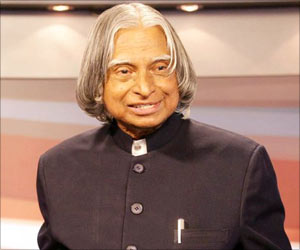Dr.Kalam collapsed while delivering a lecture at IIM-Shillong. He suffered cardiac arrest and passed away at the Bethany Hospital in Shillong.

Born in Rameswaram, Tamil Nadu, on October 15, 1931, into a Muslim boatman’s family, Dr. Avul Pakir Jainulabdeen Abdul Kalam was an Indian scientist who studied physics and aerospace engineering. After completing school, Kalam distributed newspapers to financially contribute to his father’s income. In his school years, he had average grades, but was described as a bright and hard working student who had a strong desire to learn and spend hours on his studies, especially mathematics. After completing his school education at the Ramanathapuram Schwartz Matriculation School, Kalam went on to attend Saint Joseph’s College, Tiruchirappalli, then affiliated with the University of Madras, from where he graduated in physics in 1954. Towards the end of the course, he was not enthusiastic about the subject and would later regret the four years he studied it.
He then moved to Madras in 1955 to study aerospace engineering. While Kalam was working on a senior class project, the Dean was dissatisfied with the lack of progress and threatened to revoke his scholarship unless the project was finished within the next three days. He worked tirelessly on his project and met the deadline, impressing the Dean, who later said, "I [Dean] was putting you [Kalam] under stress and asking you to meet a difficult deadline".
He narrowly missed achieving his dream of becoming a fighter pilot, as he was placed ninth in qualifiers, and only eight positions were available in the Indian Air Force at that time. He spent the next four decades as a scientist and science administrator, mainly at the Defense Research and Development Organization (DRDO) and Indian Space Research Organization (ISRO), and was intimately involved in the India’s civilian space program and military missile development efforts. After graduating from Madras Institute of Technology (MIT - Chennai) in 1960, Kalam joined Aeronautical Development Establishment of Defense Research and Development Organization (DRDO) as a scientist. Kalam started his career by designing a small helicopter for the Indian Army, but remained unconvinced with the choice of his job at DRDO.
He was also part of the INCOSPAR committee working under Dr. Vikram Sarabhai, the renowned space scientist. In 1969, Kalam was transferred to the Indian Space Research Organization (ISRO) where he was the project director of India’s first indigenous Satellite Launch Vehicle (SLV-III) which successfully deployed the Rohini satellite in near earth’s orbit in July 1980. Joining ISRO was one of Kalam’s biggest achievements in life and he is said to have found himself when he started to work on the Satellite Launching Vehicle (SLV) project. Kalam first started work on an expandable rocket project independently at DRDO in 1965.
In 1969, Kalam received the government’s approval and expanded the program to include more engineers. In 1963-64, he visited NASA’s Langley Research Center in Hampton Virginia, Goddard Space Flight Center in Greenbelt, Maryland and Wallops Flight Facility situated at Eastern Shore of Virginia. During the period between the 1970s and 1990s, Kalam made an effort to develop the Polar Satellite Launching Vehicle (PSLV) and SLV-III projects, both of which proved to be success. Kalam was invited by Raja Ramanna to witness the country’s first nuclear test Smiling Buddha as the representative of TBRL, even though he had not participated in the development, test site preparation and weapon designing. In the 1970s, a landmark was achieved by ISRO when the locally built Rohini-1 was launched into space, using the SLV rocket.
Advertisement
Kalam and Dr V S Arunachalam, metallurgist and scientific adviser to the Defense Minister, worked on the suggestion by the then Defense Minister, R. Venkataraman on a proposal for simultaneous development of a quiver of missiles instead of taking planned missiles one after another. Venkatraman was instrumental in getting the cabinet approval for allocating Rs. 388 crores for the mission, named Integrated Guided Missile Development Program (IGMDP) and appointed Kalam as the chief executive. Kalam played a major part in developing many missiles under the mission including Agni, an intermediate range ballistic missile and Prithvi, the tactical surface-to-surface missile, although the projects have been criticized for mismanagement and cost and time overruns. Kalam was the Chief Scientific Adviser to the Prime Minister, and the Secretary of Defense Research and Development Organization from July 1992 to December 1999.
Advertisement
He also played a pivotal organizational, technical and political role in India’s Pokhran-II nuclear tests in 1998, the first since the original nuclear tests were carried out by India in 1974. Elected President of India in 2002 with the support of both the ruling Bharatiya Janata Party and the opposition Indian National Congress, Kalam served for five years, and then returned to civilian life of education, writing, and public service. He has received several prestigious awards, including the Bharat Ratna, India’s highest civilian honor, the Padma Vibhushan and the Padma Bhushan, and others. During his term as President, Kalam was affectionately known as the People’s President.
In his own words, he said that the signing the Office of Profit Bill was the toughest decision he had taken during his tenure. During his presidential term, Kalam was also criticized for inaction in deciding the fate of 20 out of the 21 mercy petitions of persons on death row. At the end of his term, Kalam did express his willingness to be considered for a second term in office provided there was certainty about his victory, but two days later, he decided not to contest as he wanted to keep Rashtrapati Bhavan apolitical.
Over the last eight years, he was a visiting professor at Indian Institute of Management Shillong, Indian Institute of Management Ahmedabad and Indian Institute of Management Indore, an honorary fellow of Indian Institute of Science, Bangalore, Chancellor of the Indian Institute of Space Science and Technology Thiruvananthapuram, a professor of Aerospace Engineering at Anna University (Chennai), JSS University (Mysore) and an adjunct/visiting faculty at many other academic and research institutions across India. He has taught information technology at IIIT Hyderabad and technology at Banaras Hindu University and Anna University.
In May 2012, Kalam launched his mission for the youth of the nation called the What Can I Give Movement with a central theme to defeat corruption. He also had interests in writing Tamil poetry and in playing veenai, a South Indian string instrument. He was nominated for the MTV Youth Icon of the Year award in 2003, and in 2006. In the 2011 Hindi film I Am Kalam, Kalam is portrayed as an extremely positive influence to a poor but bright Rajasthani boy named Chhotu, who renames himself Kalam in honor of his idol.
Source-ANI








